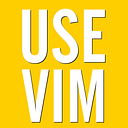Vim 101: Blockwise Visual Mode
Last week I wrote about the virtues of Visual mode in Vim 101: Visual Mode. This is the gateway to an entire class of powerful text manipulation techniques. One aspect that I find myself using regularly in my daily coding chores is blockwise Visual mode.
Blockwise Visual mode is started by typing CTRL-V when in Normal mode, and is indicated by -- VISUAL BLOCK -- in the status line. This is usually performed at the start of a line, or perhaps somewhere in the middle:
As you can see, I’ve selected a single column here. Notice how the selection is only visible on certain lines — this is where the text is longer than one line.
Once a block has been selected, editing commands can be applied. For example, the case could be switched using ~ or deleted using x. If the selection is removed (perhaps you make an edit then undo it), then it can be reselected by typing gv. Vim will remember the selection was active in blockwise Visual mode, so you'll see -- VISUAL BLOCK -- again in the status line.
Editing Columns
This is my favourite part! Not only can editing commands be made to an entire block’s selection, but they can also be applied to each line. This is amazingly useful for a programmer, and it works like this:
- Select a block by pressing
CTRL-V - Type
I - Edit the text. For example, if I wanted to prepend bullet points before each line I’d type
* - Press
<Esc> - Watch as each line is prepended with
*
This is illustrated in the gif below:
The I command is actually "block insert". You can read about this in :help v_b_I, which stands for "Visual-block Insert".
This technique is pretty easy to remember, and depending on your programming or writing style, you may find yourself using it so regularly it becomes second nature.

